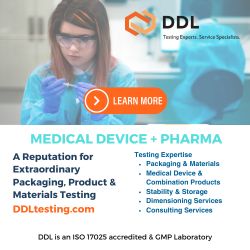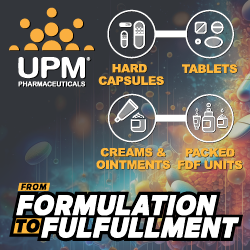Issue:January/February 2025
FOCUSED ULTRASOUND - Overcoming Drug Delivery Challenges
INTRODUCTION
Research scientists and biopharmaceutical companies continue to push the boundaries of medicine, developing treatments that offer new hope to patients with various complex conditions. Innovations like gene therapy have shown the potential to reverse genetic disorders, CAR-T therapies have enabled the immune system to target and eliminate cancer cells, and advanced HIV medications have rendered the virus virtually undetectable. In addition to these approved treatments, industry pipelines hold thousands of development candidates aimed at transforming patient care in diverse therapeutic areas.
However, some diseases remain formidable, defying even the most advanced therapies. Among these challenging conditions, glioblastoma and neurodegenerative diseases like Alzheimer’s disease present particularly high hurdles; the drug development failure rate in Alzheimer’s exceeds 98%. Many drug candidates designed to treat neurodegenerative diseases and brain cancer fail due to the blood-brain barrier (BBB), a tightly knit endothelial cell structure along the blood vessels that prevents potentially harmful substances from entering the brain but also restricts therapeutic molecules from reaching their targets.
The challenge of the BBB has spurred a wave of innovation, with scientists seeking new ways to circumvent this protective mechanism to deliver drugs effectively. One promising approach, focused ultrasound (FUS), is emerging as a revolutionary tool, enabling non-invasive, targeted BBB disruption. This method holds transformative potential in delivering therapies for neurodegenerative diseases and other challenging conditions, setting the stage for novel treatments in the years ahead.
FOCUSED ULTRASOUND: A NEW FRONTIER IN MEDICINE
Focused ultrasound uses ultrasonic energy to precisely target deep tissues without incisions, radiation, or significant side effects and can treat tissue using a variety of desired biological effects. Cleared by the US FDA, focused ultrasound ablation can treat conditions like essential tremor, Parkinson’s disease, prostate cancer, uterine fibroids, liver tumors, and pain from bone metastases. It is being explored globally in dozens of medical indications and has more than 30 regulatory approvals worldwide. By combining ultrasound and imaging technologies, FUS enables real-time monitoring, allowing clinicians to guide and adjust treatments accurately.
Focused ultrasound is the marriage of two innovative technologies:
Focused Ultrasound: provides the energy to treat tissue deep with high precision and no incisions.
Magnetic Resonance or Ultrasound Imaging: used to identify and target the tissue to be treated, guide and control the treatment in real-time, and confirm the effectiveness of the treatment.
The fundamental principle is analogous to using a magnifying glass to focus beams of sunlight on a single point to burn a hole in a leaf. With focused ultrasound, an acoustic lens is used to concentrate multiple intersecting beams of ultrasound on a target deep in the body with extreme precision and accuracy.
Where each of the individual beams passes through the tissue, there is no effect. But, at the focal point, the convergence of the multiple beams of focused ultrasound energy results in many important biological effects, creating the possibility of treating a variety of medical disorders.
One of the most promising applications of FUS lies in its capacity to temporarily and safely disrupt the BBB. The technique involves injecting microbubbles, used in the clinic as ultrasound contrast agents, into the bloodstream. When ultrasound waves are directed at the targeted brain regions, these bubbles oscillate, creating mechanical forces that temporarily push apart the endothelial cells of the BBB. The resulting temporary increase in BBB permeability can last 24 to 48 hours, during which larger therapeutic molecules (previously unable to cross the barrier) can reach their intended targets. This advancement has major implications for treating Alzheimer’s isease, Parkinson’s disease, amyotrophic lateral sclerosis (ALS), and brain tumors.
FOCUSED ULTRASOUND IN ALZHEIMER’S RESEARCH
The potential of FUS in Alzheimer’s disease treatment is supported by groundbreaking studies, including one that demonstrated the ability of the technology to safely and reversibly open the BBB in Alzheimer’s patients, specifically targeting areas of the frontal lobe where amyloid plaques are concentrated.1 Subsequent studies confirmed these results, showing not only successful BBB disruption but also measurable decreases in amyloid levels post-treatment.2
Recently, a team at West Virginia University’s Rockefeller Neuroscience Institute used FUS to improve the delivery of aducanumab, an anti-amyloid drug for Alzheimer’s disease initially approved in 2021.3 Using MRI-guided focused ultrasound directed to specific brain regions, they achieved targeted BBB opening, allowing higher concentrations of aducanumab to enter the brain. PET scans confirmed that the side of the brain treated with FUS had a significant reduction in amyloid plaques compared to the untreated areas, highlighting the approach’s potential to accelerate plaque clearance due to enhanced drug delivery with FUS BBB opening.
While aducanumab was recently removed from the market due to efficacy concerns, this study now continues with Lecanemab. Ongoing research is exploring FUS-assisted BBB opening in combination with other anti-amyloid drugs, seeking alternative treatment pathways for Alzheimer’s disease patients.

EXPANDING THE REACH OF FOCUSED ULTRASOUND IN ONCOLOGY
Oncology is also a major area of interest for researchers exploring the use of FUS, with clinical trials examining the potential to enhance drug delivery for brain tumors, such as glioblastoma (GBM). GBM is the most common glioma and occurs in 3 per 100,000 people annually in developed countries, is not curable, and has a grim prognosis (a 5-year survival rate of less than 10%) that has remained unchanged for more than 30 years.
These aggressive cancers often resist traditional therapies, partly due to the BBB’s role in blocking chemotherapeutics. By transiently disrupting the BBB, FUS could allow chemotherapy drugs to more effectively reach tumor cells, potentially improving patient outcomes. Preliminary studies have shown promising results, paving the way for larger clinical trials.
A team of French researchers recently conducted a comprehensive review of preclinical and clinical studies to summarize the varying approaches of using focused ultrasound to deliver anticancer drugs across the BBB and blood-tumor barriers for the treatment of glioma.4
The team analyzed 60 published studies (51 preclinical and 9 clinical trials). Among these, there were 29 that delivered free drugs (22/29 preclinical), 22 that employed drug-loaded nanoparticles (20/22 preclinical), and 9 that used drug-loaded microbubbles (all preclinical). Both large- and small-molecule anticancer agents have been delivered, including conventional chemotherapies, monoclonal antibodies, immunotherapies, and modified cell-based therapies. These various therapies were introduced via intravenous bolus, intravenous infusion, intraperitoneal injection, orally, intranasally, or intra-gastrically. At the time of publication, 13 GBM additional clinical trials were ongoing.
Through these studies, the safety and feasibility of using focused ultrasound BBB disruption (FUS-BBBD) has been established for different FUS devices, repeated sessions, and different chemotherapies in patients with newly diagnosed GBM, recurrent GBM, and high-grade gliomas.
The authors found that using focused ultrasound for BBBD improved the intracerebral concentration of anticancer therapies in both healthy brains (a 1.4- to 16.6-fold increase) and in glioma models (a 1.6- to 8-fold increase) compared with the non-sonicated contralateral hemisphere. In glioma models, focused ultrasound increased the delivery of the therapeutic agents in the healthy contralateral hemisphere, averaging 4.2-fold for small molecules and small targeted therapies, and 3.6-fold for larger monoclonal antibodies. Furthermore, transient focused ultrasound BBB disruption also improved the concentration of anticancer therapies in brain tumors when compared with non-sonicated tumors (a 1.4- to 13.9-fold increase). As might be expected, this increase was higher for small molecules (5.2-fold) than for monoclonal antibodies (3.7-fold).
TACKLING THE CHALLENGE OF GENE THERAPY DELIVERY
FUS is also being explored to address the challenge of gene therapy delivery.
Designing an effective delivery system that ensures the nucleic acid reaches target cells or tissues without being degraded or causing off-target effects is one of the most critical challenges facing the field of gene therapy. A therapy that can’t reach its intended target at a sufficient dose will not succeed, as it could either fail to elicit the desired biological response or, worse, cause unintended consequences in healthy cells. Success in this area is essential to unlock the full potential of gene therapy for treating a wide range of genetic disorders.
Several presentations at the 2023 Focused Ultrasound and Gene Therapy Workshop hosted by the Focused Ultrasound Foundation emphasized that FUS offers a platform to non-invasively increase the delivery efficiency of both viral and non-viral gene therapy vectors.5 This could expand therapeutic reach to larger tissue volumes rather than direct injections, with more uniform distribution while requiring lower vector doses that improve safety and manufacturing feasibility. At the workshop, researchers presented data demonstrating the feasibility of targeting diverse brain regions and cell types without overt toxicity. Enhanced delivery of adeno-associated viruses (AAVs), lipid nanoparticles, and other vectors have been shown across animal models.
While FUS can temporarily and reversibly open the BBB for gene therapy delivery using viral vectors, challenges remain in terms of efficiency and specificity. One approach to addressing this is to engineer viral capsids specifically for FUS delivery.6 In one study discussed at the workshop, a library of mutated capsids was injected into transgenic mice, and FUS was applied to one hemisphere. After transduction, the hemispheres were analyzed to identify variants enriched in the FUS-targeted side. This resulted in five capsid candidates that exhibited specific enrichment up to 2.5-fold in the brain; one variant showed over 10X combined improvement in brain targeting.
A PROMISING FUTURE FOR FOCUSED ULTRASOUND
Focused ultrasound is redefining how clinicians approach some of the most challenging diseases, particularly those affecting the brain. The technology’s versatility has fueled a wave of new clinical applications, offering potential in disease areas where traditional therapies have fallen short. With its capacity to safely disrupt the BBB, FUS may become a cornerstone in treating neurodegenerative diseases, genetic diseases, and brain cancer, advancing the goals of precision medicine, and providing hope to millions affected by these conditions.
As research progresses, FUS is likely to play a pivotal role in the treatment landscape, not only in neurology but also in cancer and beyond. For drug developers and clinicians, FUS opens new avenues for drug delivery, enabling more effective therapies for diseases that previously seemed beyond reach. This promising technology underscores the power of innovation in medicine, revealing new possibilities for the future of patient care.
REFERENCES
- Lipsman N, et al. Blood-brain barrier opening in Alzheimer’s disease using MR-guided focused ultrasound. Nat Commun. 2018 Jul 25;9(1):2336. doi: 10.1038/s41467-018-04529-6. PMID: 30046032; PMCID: PMC6060168.
- Chang KW, et al. Blood-Brain Barrier Opening in Magnetic Resonance Images. J Korean Neurosurg Soc. 2023 Mar;66(2):172-182. doi: 10.3340/jkns.2022.0236. Epub 2022 Dec 20. PMID: 36537034; PMCID: PMC10009247.
- Rezai AR, et al. Ultrasound Blood-Brain Barrier Opening and Aducanumab in Alzheimer’s Disease. N Engl J Med. 2024 Jan 4;390(1):55-62. doi: 10.1056/NEJMoa2308719. PMID: 38169490.
- Bérard C, et al. Anticancer drug delivery by focused ultrasound-mediated blood-brain/tumor barrier disruption for glioma therapy: From benchside to bedside, Pharmacology & Therapeutics. (2023) 250:108518. https://doi.org/10.1016/j.pharmther.
- 2023 Focused Ultrasound for Gene and Cell Therapy Workshop. https://cdn.fusfoundation.org/2024/05/01084708/Focused-Ultrasound-Foundation-Gene-Therapy-Workshop-White-Paper-2023.pdf.
- Li H, et al. Engineering Viral Vectors for Acoustically Targeted Gene Delivery. bioRxiv. (2021) doi:10.1101/2021.07.26.453904.

Neal F. Kassel, MD, is the founder and Chairman of the Focused Ultrasound Foundation and former Co-Chair of Neurosurgery at the University of Virginia. He has published more than 500 scientific papers and book chapters, and his research has been supported by over $30 million in NIH and industry grants and contracts. A member of numerous medical societies in the US and abroad, he has served on many standing and ad hoc committees of the National Institutes of Health and in an editorial capacity for a variety of academic journals. In April 2016, he was named to the Blue Ribbon Panel of then-Vice President Joe Biden’s Cancer Moonshot Task Force. He is a founder of numerous private ventures, including Interax, Inc.; the Virginia Neurological Institute; Multimedia Medical Systems, Inc.; the Neuroclinical Trials Center; the NeuroVenture Fund; and MedSpecialists.net. He has served on a number of corporate and not-for-profit boards, including Eclypsis Corporation; INC Research; the Prostate Cancer Foundation; Insightec, Ltd.; the Expedition Trust Company; Tuesday Evening Concert Series and Virginia National Bank. He is currently a Director of the Focused Ultrasound Foundation. He is a shareholder in Insightec, Ltd., where he also served on the board until 2012. He earned his undergraduate and medical education at the University of Pennsylvania.
Total Page Views: 3211













